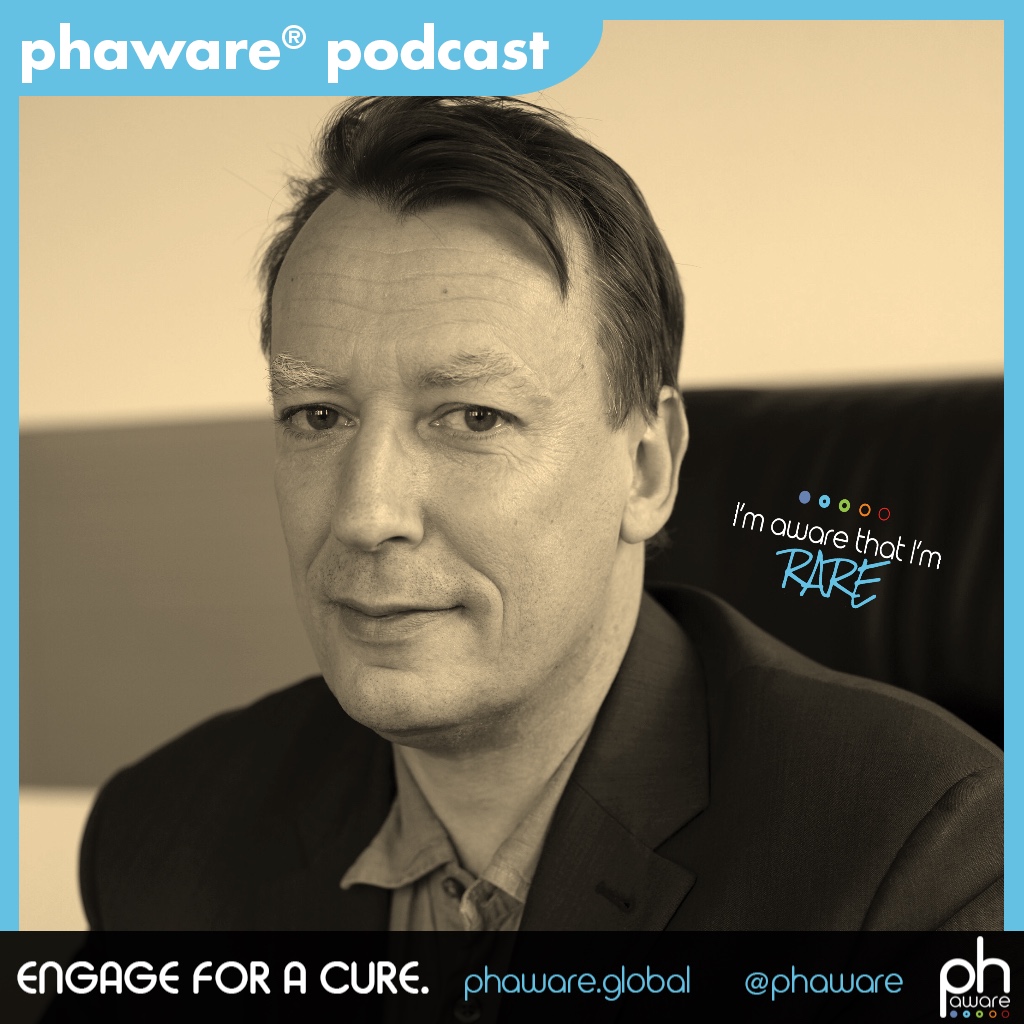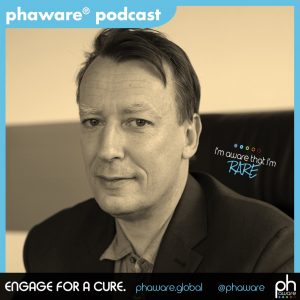Phaware Podcast: Marc Humbert, MD

This podcast series, created and produced by phaware, is being offered as a regular guest feature on Pulmonary Hypertension News to bring the voices and life experiences of PH patients, family members, caregivers, healthcare specialists, and others to our readers. You may listen to the podcast directly, or read it via the transcript that runs below.
I’m Aware That I’m Rare: Marc Humbert, MD
The phaware® interview (Episode 115)

Marc Humbert, MD, PhD, is a professor of respiratory medicine at South Paris University (Université Paris-Saclay) in Le Kremlin-Bicêtre, France. He is the Director of the National Reference Centre for Pulmonary Hypertension, Department of Respiratory and Intensive Care Medicine, Hospital Bicetre, Assistance Publique Hôpitaux de Paris, France. He is the Chief Editor of the European Respiratory Journal (impact factor 10.57). Dr. Humbert has published over 700 peer-reviewed manuscripts. He discusses pulmonary arterial hypertension (PAH) and the inflammatory component of this condition.
My name is Marc Humbert. I’m a pulmonologist at the South Paris University, and I’m the director of the French National Reference Center for Pulmonary Hypertension in Paris.
Today, I’m going to discuss pulmonary arterial hypertension and I will focus more strongly on the inflammatory component of this condition.
It’s clear that PAH, as we say, is due to remodeling of the small pulmonary arteries, and this leads to increased pulmonary vascular resistance and right heart failure. Usually, we don’t mention inflammation; however, in PAH, we know that some patients have comorbid conditions, the clearest ones being connective tissue disease, you know? If you have PAH in the setting of systemic lupus erythematosus, if you have scleroderma, there is an autoimmune condition associated with PAH. Similarly, when you are infected by HIV, you have an immune disturbance which can be quite pronounced, and also when you have liver disease with portal hypertension, you have inflammatory reactions occurring in your body.
So, these conditions, they all have an inflammatory flavor, and these conditions sometimes, they can be treated with anti-inflammatory treatments, such as corticosteroids. We know, for example, that in systemic lupus erythematosus, some patients with very severe PAH may improve significantly with steroids and other therapies which interfere with inflammation.
So, that’s really a background of what is obvious in PAH. You may have PAH with a clear-cut inflammatory condition. In some patients with this inflammatory condition, you can treat the inflammation and improve PAH, but that’s of course a sub-category of the patients with pulmonary arterial hypertension, not all of them.
What is really interesting in PAH is that you have also forms of PAH which are not associated with autoimmune disease. You may have what we call idiopathic PAH or familial PAH. What has been really interesting in our early work, 20-25 years ago, is that we identified abnormal inflammatory responses in patients with so-called idiopathic PAH. So inflammation can contribute to disease mechanisms in patients with associated condition whatsoever.
So, for example in idiopathic PAH we found that some patients were characterized by elevated cytokines level in the bloodstream, you know, elevated levels of interleukin-6 or interleukin-1. That was quite clear and very descriptive: There was a difference between the controls and the patients with PAH. The patients with idiopathic PAH had more evidence of inflammation, as evidence by circulating cytokines.
Another very interesting thing is that when we were screening for autoimmunity, patients with no evidence of autoimmune disease, had auto-antibodies circulating in the bloodstream. That was quite important because we had patients with anti-nuclear antibodies, etc. And this was what some people called “forme fruste” of autoimmunity. A kind of weak signal of autoimmunity.
Then we did a lot of transplantation in patients with pulmonary arterial hypertension, and we had, of course, access to the lung tissue of patients with severe PAH. What was quite clear is that in patients with PAH there was inflammation surrounding the small pulmonary vessels. Indeed, small pulmonary vessels in PAH are usually remodeled, so it means that they are thickened, the wall is remodeled, you have too many smooth muscle cells, too many endothelial cells and it’s plugged by proliferation. When you analyze the vessel in its totality, you find that there are some inflammatory cells, what we call T-lymphocytes, B-lymphocytes, macrophages, mast cells, dendritic cells, and this is important because these infiltrating inflammatory cells, they can lead to local damage. That was quite important to identify.
Another very important thing is that sometimes these inflammatory cells are organizing themselves and they are connecting with each other, and it was quite clear that in some cases there was some kind of lymph node-like lesions around the vessel. One could link that to the autoimmune process. You can imagine that around the vessel there could be some immune reaction against the vessel itself, and this could lead to autoimmunity, this could lead to tissue damage, and this could lead to progression of the disease.
Of course, this is in human being and we cannot do more than describing what is going on, and then we analyzed animal models of the disease, you know, experimental models of the disease. It was clear in several of these models that inflammation was not only present but could be targeted with therapy. So it was possible in some experimental model of pulmonary hypertension, not only to see a similar inflammation around the vessel, but also treatable inflammation. So, you could target it with immunosuppressants or with corticosteroids and obtain improvements in these experimental models.
We have progressed a lot now and human diseases are better analyzed with novel technology, especially when we do transplantation we can analyze in great detail what is going on in the lungs. Clearly, there is a network of inflammatory cells, which not only accumulate, but they do act within the lesions, and it is clear that novel therapeutic options are now tested in patients with PAH in order to interfere with these inflammatory mediators. So, it’s not only inflammatory cells, it’s also inflammatory mediators. You could say cytokines, I mentioned interleukin-6; you could say leukotrienes; you could say auto-antibodies, etc. All these elements can be targeted with smart drugs which interfere with these pathways.
So, currently we have plenty of drugs to improve PAH and we combine them, etc., but we need maybe a novel target, something which could be used not to replace what we have right now, but on top of what we have right now. Clearly there are some studies right now in the world, in the United States led by Stanford University, or in the U.K. led by Cambridge, or in France led by South Paris University. All these studies clearly have the same objective. It’s not to say we are going to find, right now, something totally groundbreaking. But we may find something which could be an important option on top of what we have right now in order to delay clinical worsening, to improve outcomes, to improve quality of life of our patients and that’s clearly what many, many people try to do.
Right now, there are studies ongoing, there are studies with recruitment of patients and we should hear from the results of these studies I think next year, mid next year at the latest. And that’s very interesting for us because we started a long time ago with descriptive studies, then we confirmed that in experimental models but experimental models do not tell you much than it may be important. And now we have access to interventions in patients who received best standard of care. They are not undertreated, they receive what they should receive, but on top of that they receive another agent which influences the inflammatory process and that’s quite important to study.
My name is Marc Humbert, and I’m aware that I’m rare.
EVERYBODY HAS A STORY. WHAT’S YOURS?
Phaware global association wants to share your pulmonary hypertension story with their engaged global audience. Whether you are a patient, caregiver, or medical professional, they are enlisting PH community members from around the world.
Visit www.phawarepodcast.libsyn.com/contact to share your story and to be considered for a future episode. Never miss an episode with the phaware® podcast app. Learn more about pulmonary hypertension at www.phaware.global. #phaware
Note: Pulmonary Hypertension News is strictly a news and information website about the disease. It does not provide medical advice, diagnosis, or treatment. This content is not intended to be a substitute for professional medical advice, diagnosis, or treatment. Always seek the advice of your physician or other qualified health provider with any questions you may have regarding a medical condition. Never disregard professional medical advice or delay in seeking it because of something you have read on this website. The opinions expressed in this column are not those of Pulmonary Hypertension News or its parent company, Bionews Services, and are intended to spark discussion about issues pertaining to pulmonary hypertension.









Leave a comment
Fill in the required fields to post. Your email address will not be published.